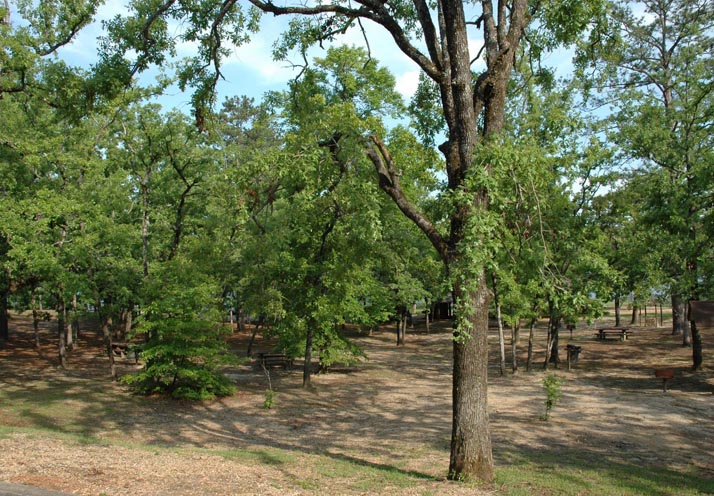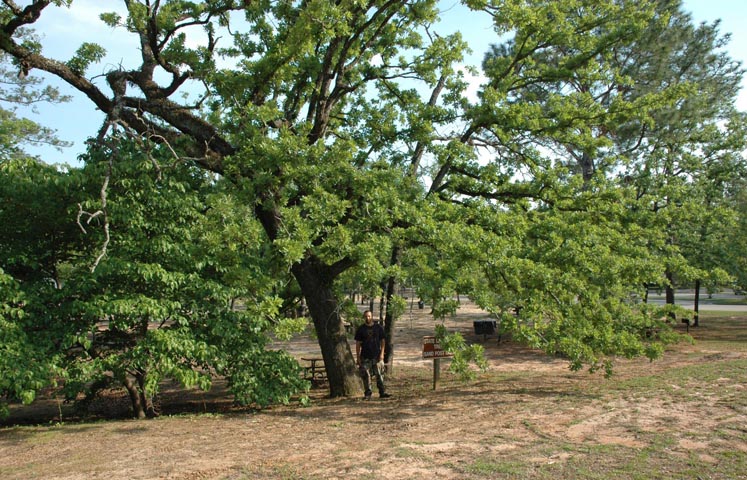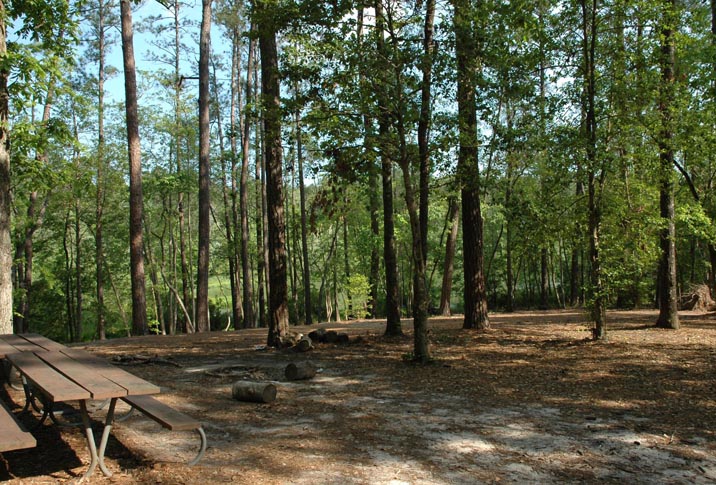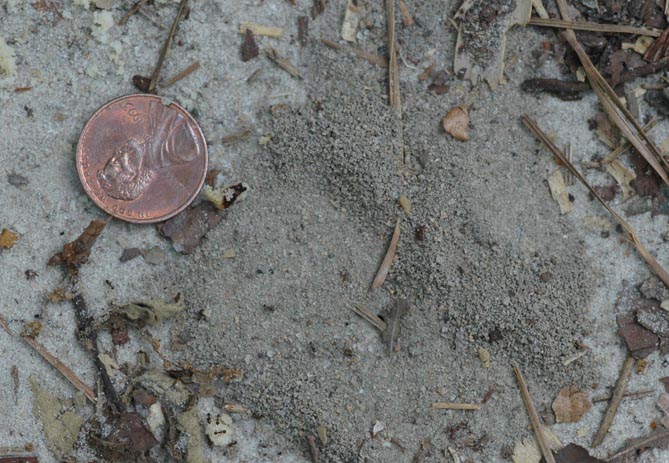Ants in Clarkco State Park, Clarke County, Mississippi, 4 May 2006 [MS State Park Ants]
Joe A. MacGown and JoVonn G. Hill
Clarkco State Park, in Clarke County, Mississippi is located just south of Meridian near the Mississippi-Alabama state line. This state park is situated on 815 acres of mostly hilly forests and is centered around a 65-acre lake. The park offers cabin rentals and both primitive and improved camping. There is a three-mile nature trail that winds through the mixed pine-hardwood forest.
On 4 May 2006 Joe MacGown and JoVonn Hill collected ants and various other insects at Clarkco State Park. We arrived at the park around 2:00 P.M. on a beautiful sunny day with temperatures reaching the lower to mid 80's. Upon arriving at the park, we first went to the office and talked to the park ranger to let him know what we were up to. He was all for us collecting ants, but suggested that we should take a few million specimens back with us. At first we thought he was probably referring to fire ants, Solenopsis invicta Buren, but as we walked out the door back to the truck we noticed that the ant nests we first assumed belonged to fire ants were actually those of Argentine ants (Linepithema humile Mayr). This is not an ant you want to find when collecting because were they are found they occur in such tremendous numbers that they force many other species away.

The picnic area near the office (also known as the land of Argentine ants)
After leaving the office, we went over to the nearby picnic area (at 32°06'10"N88°41'51"W) to see what ants were crawling about. From a distance this spot looked ideal for ant collecting as it was a nice open wooded area with sandy soil (usually the perfect place for ants). Two of the trees present, a turkey oak (Quercus laevis Walt.) and dwarf post oak (Quercus margaretta Ashe ex Small), had signs placed before them labeling them as being state record trees. There were also a variety of other trees present. Unfortunately, as we walked around the picnic area it soon became apparent that the only ants we were likely to collect there were Argentine ants. Similar to other localities where this ant is present, they were seen in great numbers both on the ground and on trees. Despite the likelihood of our only collecting Argentine ants here, we placed 10 bait stations with cookie bait in them at the bases of trees and put peanut butter bait on several of the larger trees. These baits were to be checked later after we collected at another spot in the park.

JoVonn, posing beside the mighty dwarf post oak record tree.
We left the Argentine ant infested picnic area and searched for a place that lacked them. We drove around until we came to the primitive campground, which looked like nice ant habitat and was in some very nice mixed woods at 32°06'13"N88°41'17"W. We parked the car near some picnic tables on a hilltop overlooking the lake. The area here was an open wooded habitat with loblolly pine (Pinus taeda L.) and a variety of hardwood trees present including blackjack oak (Quercus marilandica Muenchh.), laurel or willow oak (Quercus sp.-we weren't quite sure which species it was), cherry (Prunus serotina Ehrh.), pecan (Carya sp.), sweetgum (Liquidambar styraciflua L.), dogwood (Cornus florida L.), flowering magnolia (Magnolia grandiflora L.), American holly (Ilex opaca Ait.), and a variety of others. The soil was very sandy, but with large areas of chipped wood present. There were also quite a few cut logs present in the area. We assumed the logs, the wood chips, and the number of downed trees in the area were lingering results from Hurricane Katrina. The forest surrounding the picnic/camping area was thicker with more undergrowth and low wet areas intermingled. We looked around a bit and finding no presence of Argentine ants, we decided to collect here. First we put some peanut butter bait on some large trees in the open wooded picnic area.

A nice view of the primitive campground area.
After baiting the trees we looked around for other ants. We saw Camponotus americanus Mayr, C. chromaiodes Bolton, C. snellingi Bolton, Formica pallidefulva Latreille, and Prenolepis imparis (Say) crawling around in this area. Colonies of Trachymyrmex septentrionalis (McCook), Pheidole metallescens Emery, and Pheidole bicarinata Mayr were found in the sandy soil. Looking under some small oak logs, several colonies of Aphaenogaster sp. cf. carolinensis Wheeler were discovered. Under a shallow pile of moist wood chips, a colony of Aphaenogaster treatae Forel was found. Paratrechina faisonensis (Forel) colonies were found in soil at the bases of several trees. Pheidole dentigula Smith was found nesting at the base of a deciduous tree in the woods. Some small colonies of Solenopsis invicta were found along the dirt road leading to the camping area, but this species was not overly common at this site (yeehah).

The crater mound of Pheidole bicarinata.
A young colony of Aphaenogaster lamellidens Mayr was collected in the bark of a large loblolly pine on a hillside in the woods. Also nesting in bark of the same tree were several colonies of Solenopsis sp. cf. molesta (Say). Although entire colonies appeared to have been present, no queens were found. Sweeping vegetation along the lake yielded Pseudomyrmex ejectus (F. Smith), Pseudomyrmex pallidus (F. Smith), and Colobopsis impressa Roger. Hand sifting leaf litter taken from the base of two large loblolly pines yielded Aphaenogaster fulva Roger, A. mariae Forel, Pheidole dentata Mayr, and several workers of Strumigenys rostrata Emery.
We collected four gallons of soil and leaf litter samples from the area. One bag was collected from the bases of several large trees in the open picnic area, one from litter beside rotting wood, and the other two samples from the thicker forested area near the nature trail. The litter sample from the picnic area had some rather interesting ants in it including Ponera exotica Smith and Temnothorax tuscaloosae Wilson. These two species were only recently noted as occurring in Mississippi (MacGown and Brown, 2006). Temnothorax tuscaloosae is considered by many ant taxonomists to be a very rare species and it was exciting to collect it here. Also in the same sample was the smallish black carpenter ant Camponotus nearcticus Emery, which we had not collected otherwise in the park. In addition to several common species collected by hand, the litter sample from beside the rotting log had Paratrechina faisonensis (Forel), Pachycondyla gilvaRoger, Strumigenys ornata Mayr, and Myrmecina americana Emery present in it. Both Paratrechina faisonensis and M. americana are very common woodland species. Pachycondyla gilvais an uncommonly collected ant that is typically found in soil and leaf litter in deciduous or mixed pine/deciduous forests. Strumigenys ornata is a very unique, tiny ant that possesses strange elongate hairs on its head that radiate outward in a fan-like manner. However, this species appears to be relatively common in Mississippi. The litter samples from the forested area surrounding the primitive camping and picnic area had a variety of species including several species that we collected by hand as well as Hypoponera opacior (Forel), Ponera exotica Smith, Discothyrea testacea Roger, Strumigenys clypeata Roger, Strumigenys dietrichi Smith , Strumigenys ohioensis Kennedy & Schramm, Strumigenys ornata Mayr, and M. americana. Discothyrea testacea is yet another ant that was only recently added to the list of ants known from Mississippi (MacGown and Brown, 2006) and we collected 4 workers of that species here. Ants in the genus Pyramica are all tiny cryptic ants that live in soil and leaf litter and prey on a variety of small organisms such as Collembola and small centipedes. They are cool ants that possesses unusually modified setae, elongate mandibles, and spongiform-like tissue (underneath the waist area). Previous to recent collections by the Mississippi Entomological Museum, very few records of this genus were reported from Mississippi. However, now we routinely find them and have found them to be our most diverse genus in the state with at least 21 species known (MacGown et al, 2005).
After collecting in this area until about 4:30 or so, we checked the peanut butter that was placed on several of trees throughout the campground and found Camponotus decipiens Emery, Pheidole bicarinata Mayr, P. dentata Mayr, Crematogaster ashmeadi Mayr, and Temnothorax schaumii Roger. The Camponotus, Crematogaster, and Temnothorax species are arboreal nesting ants, whereas P. bicarinata nests in the soil and P. dentata nests in a variety of places including the soil and rotting wood. Temnothorax schaumii is an easily overlooked species that is very cryptic and slow moving. We have found them nesting in the bark of oak trees. Baiting with peanut has proved to be a suitable method of collecting them, although one must still have a sharp eye because they blend in with the bark.
After checking the peanut butter we decided to call it quits and headed back to the picnic area near the office to check the baits there. Only one of the 10 bait stations had any ants in it, and you guessed it, they were Argentine ants. It was interesting and somewhat surprising that the other nine stations had no Argentine ants in them. The only ants seen at or near the peanut butter was also Argentine ants. We gave the area one more cursory search, hoping to find some other species of ants, such as Carpenter ants, but we had no such luck. As it was now after 5:00 P.M. we decided to leave the park to go back to Starkville, which was almost two hours away.
MacGown and Hill made a return visit to the park on 2 July 2010. We collected at the picnic area (32°06'09"W 88°41'49"N ), the campground area (32°06'12"N 88°41'27"W), and the nature trail near the park entrance (32°06’05”N 88°41’59”W). On this trip we collected 28 species of ants, including eight species not previously collected: Brachymyrmex patagonicus, Camponotus castaneus, Dorymyrmex bureni, Monomorium minimum, Nylanderia faisonensis, Ponera pennsylvanica, Pyrmica hexamera, and Temnothorax pergandei. SImilar to the first visit, Argentine arts were again abundant, especially in the picnic area and near the headquarders. Additionally, two exotic species not found during the first visit, B. patagonicus and S. hexamera , were discovered.
Overall, and despite the overwhelming presence of Argentine ants in the park, we found considerable diversity of ants and several rare and uncommonly collected species. A total of 48 different species from 5 subfamilies were collected.
List of ant species collected (arranged alphabetically by genus)
Aphaenogaster carolinensis Wheeler
Aphaenogaster fulva Roger
Aphaenogaster lamellidens Mayr
Aphaenogaster mariae Forel
Aphaenogaster treatae Forel
Brachymyrmex patagonicus Mayr
Camponotus americanus Mayr
Camponotus castaneus (Latreille)
Camponotus chromaiodes Bolton
Camponotus decipiens Emery
Camponotus nearcticus Emery
Camponotus snellingi Bolton
Colobopsis impressa Roger
Crematogaster ashmeadi Mayr
Crematogaster pilosa Emery
Pachycondyla gilva (Roger)
Discothyrea testacea Roger
Dorymyrmex bureni (Trager)
Formica pallidefulva Latreille
Hypoponera opacior (Forel)
Linepithema humile Mayr
Monomorium minimum (Buckley)
Myrmecina americana Emery
Nylanderia faisonensis (Forel)
Ponera exotica Smith
Pheidole bicarinata Mayr
Pheidole dentata Mayr
Pheidole dentigula Smith
Pheidole metallescens Emery
Ponera pennsylvanica Buckley
Prenolepis imparis (Say)
Pseudomyrmex ejectus (F. Smith)
Pseudomyrmex pallidus (F. Smith)
Solenopsis invicta Buren
Solenopsis sp. cf. molesta (Say)
Strumigenys clypeata Roger
Strumigenys dietrichi Smith
Strumigenys hexamera (Brown)
Strumigenys louisianae Roger
Strumigenys ohioensis Kennedy & Schramm
Strumigenys ornata Mayr
Strumigenys rostrata Emery
Temnothorax curvispinosus Mayr
Temnothorax pergandei Emery
Temnothorax schaumii Roger
Temnothorax tuscaloosae Wilson
Trachymyrmex septentrionalis (McCook)
MacGown, J. A., R. L. Brown, and J. G. Hill. 2005. An annotated list of the Pyramica (Hymenoptera: Formicidae: Dacetini) of Mississippi. Journal of the Kansas Entomological Society 78: 285–289. [pdf]


